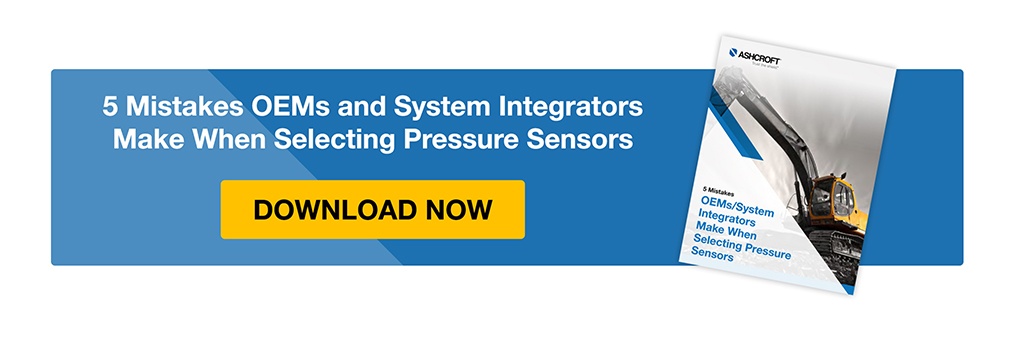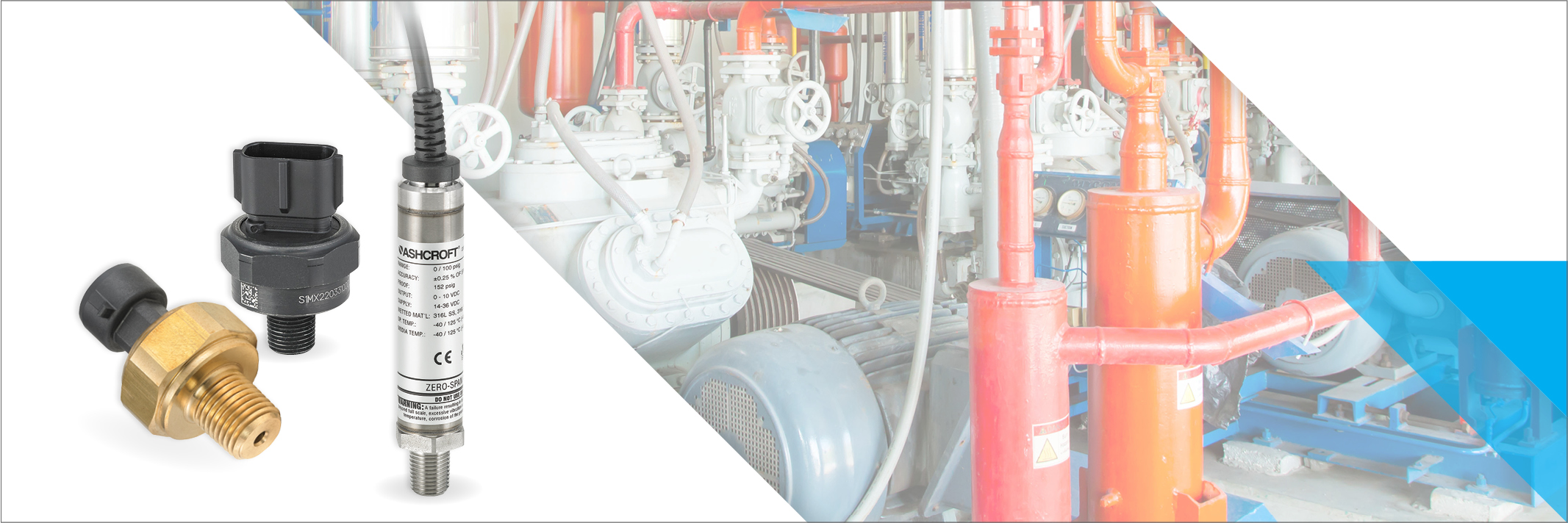4 Factors to Consider When Choosing a Pressure Transducer for Ammonia Refrigerant Applications
Ammonia | pressure transducer | Pressure Instruments | Refrigerant Applications
Now more than ever, industrial leaders are taking measures to protect the environment. For example, if you are in the HVAC/R business you may be using a more ecologically friendly refrigerant compound like ammonia to help reduce your energy consumption and greenhouse gas emissions. If this is the case, you need to be aware of certain risks and solutions that can help minimize potential danger.
According to the American Society of Heating, Refrigerant and Air-Conditioning Engineers (ASHRAE), ammonia is an ideal alternative to traditional chlorofluorocarbon refrigerant compounds because of its low impact on the environment. However, in certain quantities, ammonia can also be hazardous to people and animals.
That’s why systems with ammonia and similar refrigerant-based compounds need to have quality components, including pressure sensors. In some ammonia-based systems – such as those used in fuel pump controls – using the wrong kind of OEM pressure transducer could lead to leaks or bursts that cause serious harm to operators and equipment.
As a product leader specializing in pressure sensors for 30 years, I know what to look out for when it comes to selecting an OEM pressure transducer for applications dealing with refrigeration and ammonia. This article will go into detail about the pros and cons of using an ammonia refrigerant and the four factors you should consider when selecting the right pressure transducer for your specific needs.
Why Ammonia is Desirable for Refrigerant Applications
Environmentally Friendly: Data published by ASHRAE and other organizations shows ammonia is a natural refrigerant that has zero ozone depletion potential (ODP) and a negligible global warming potential (GWP). Studies indicate ammonia does not deplete the ozone layer or contribute to increased temperatures in the atmosphere like CO2 and other greenhouse gases.
Energy Efficiency: Ammonia has excellent thermodynamic properties, making it highly energy efficient as a refrigerant. It also has a high latent heat of vaporization, which means it absorbs a significant amount of heat when it evaporates, resulting in efficient cooling and lower energy consumption.
Wide Temperature Range: Ammonia has a broad operating temperature range, allowing it to be used in various cooling applications. It can be utilized for both high-temperature and low-temperature refrigeration, making it versatile for different industries and applications.
Cost-Effective: Ammonia is cost-effective compared to synthetic refrigerants. It is widely available and relatively inexpensive, reducing operational costs for businesses using ammonia refrigeration systems.
Safety: While ammonia is classified as a toxic substance, it has been used as a refrigerant for over a century and has established safety protocols in place. Properly designed and maintained ammonia refrigeration systems can be operated safely, and industry standards ensure the safety of workers and the surrounding environment.
 One Reason Ammonia May Not Be the Perfect Refrigerant Choice
One Reason Ammonia May Not Be the Perfect Refrigerant Choice
While ammonia has its benefits, it is not a perfect refrigerant – especially in large systems with many kinds of materials and connections. Ammonia is often incompatible with the wetted materials most frequently used in fluid vessels and tubing, especially copper or copper alloys like brass and bronze. Therefore, systems designed to handle ammonia require all wetted components to be constructed with compatible materials, such as stainless steel. Failure to do so could result in component failure and a containment breach.
4 Factors to Look for in Pressure Transducers for Ammonia Refrigerant Systems
Now that you know why ammonia is such a popular compound for modern refrigeration applications, let’s discuss the pressure transducer characteristics will need. The goal here is to get peak performance from your system and prevent failures that put your team, inventory or operations at risk.
1. Accuracy
Finding a transducer that meets the accuracy requirement of an application can be difficult. This is because there are no industry standards when it comes to stating the accuracy of a pressure transducer. Accuracy is often noted as a percentage of the full span of the device and consists of these main components:
- Non-linearity
- Hysteresis
- Repeatability
- Zero Offset
- Span offset
Unfortunately, many sensor manufacturers often don’t provide the complete picture of their products' performance, leaving information such as offset errors off their datasheets. Others hide the performance of their sensor by using “Best Fit Straight Line” or “Root Sum Squared” accuracy statements.
Having a transducer that meets your accuracy requirements will provide you with a sensor that will maximize the performance of your system or device. If you’re not sure about the accuracy of a transducer you should contact the manufacturer to get more info.
Ashcroft’s line of pressure sensors uses our proven chemical Vapor Disposition (CVD) technology that helps maintain reliability and accuracy across mid- to high-pressure applications. The sensor has four distinct polysilicon stage layers atop a stainless steel diaphragm. A Wheatstone bridge circuit is then used to tie the layers together and link directly to the system’s electronics. To learn more about the importance of accuracy, you can read my blog article, “How Accurate Are Your HVAC System’s Pressure Instruments?”
2. Material compatibility
As mentioned previously, ammonia isn’t compatible with all materials. Therefore, it is important to make sure that any wetted part of the transducer is chemically compatible with ammonia.
Most reputable suppliers list the material makeup of the wetted components such as the diaphragm and socket of the transducer on their datasheet so you can verify the compatibility of these materials in your application. Some manufacturers, including Ashcroft, even provide material compatibility information on their website to help you determine whether the transducer will work reliably in your application.
3. Process & electrical connections
In addition to reliability, choosing a transducer that is easy to install and wire into your system can be extremely helpful and cost-effective. Because of the variety of ammonia and refrigerant applications, it’s important that your transducer supplier can supply a wide range of process and electrical connection options.
Process connections can vary in type from male and female tapered threaded connections like NPT or BSPT style threads to straight treads like SAE fittings designed for low-pressure automotive and refrigeration applications to special high-pressure fittings made for applications from 10,000 psi and up.
Electrical connections can vary from those with lead wires or a short run of cable exiting the back end of your transducer to a wide selection of specialized connectors like M12, Deutsch®, Metri-Pack® or DIN connectors.
When choosing the proper electrical connector, consider:
- The number of wires you need to install the transducer into your application
- How easy it is to connect the mating wire harness
- The importance of using a connector that has the proper IP (Ingress protection) rating for your application.
If have any questions about whether a particular process or electrical connector is right for your application, contact your supplier for additional information.
4. Approvals and certifications
Many applications that use transducers in systems with ammonia or other refrigerants will require the transducer to have special certifications, or meet specific approval requirements. These can include:
- Standard approvals governed by agencies like UL, FM and ETL
- Refrigeration-specific approvals that are governed by agencies such as UL, CSA, ETL and NSF
- Hazardous location approvals such as flameproof/explosion-proof, intrinsically safe, non-incendive and increased safety, which are governed by approval agencies such as FM, UL, CSA, ATEX and IECEx.
Each of these agencies tests products to verify that meet the requirements of these specifications to make sure they are safe to install and will meet the performance requirement of the application.
There are also product certifications that suppliers can use to self-certify the product, or third-party agencies that can verify products meet the requirements of these certifications. These include Safety Integrity Level (SIL), CE/UKCA and Restriction of Hazardous Substances (RoHS).
In the end, suppliers should be able to provide certificates or documentation backing up the approvals they list on their website or datasheet.
Last Word on Pressure Transducers for Ammonia Refrigerant Applications
After learning about the benefits of using an ammonia refrigerant and the four factors to consider when selecting the right pressure transducer for your specific needs, I want to underscore one primary point: when used properly, ammonia and related compounds can be a safe, highly efficient refrigerant that doesn’t release harmful substances into the environment.
However, if the systems using it aren’t configured safely, ammonia can cause equipment malfunctions and harm to operators. Now that you understand the concerns about selecting pressure sensors, you can conduct a more targeted search for the specific transducers you need.
Ashcroft has several pressure transducer options available for ammonia refrigerant applications. The E2G transducer, for example, was designed for challenging applications and made with all-welded 316L stainless steel, which is resistant to ammonia’s corrosive properties.
If you are looking for a mid-to high-volume, cost-effective option that meets all the latest safety and performance requirements, try the S1 pressure transducer.
Want to learn more about pressure transducers in applications with strict requirements? Check out some of our other related articles:
Choosing the Right Pressure Sensor: 5 Factors to Consider
How Accurate Are Your HVAC System’s Pressure Instruments?
How Are Pressure Transducers Affected by Hydrogen Permeation?
If you’d like to learn more about selecting the right pressure sensor, download our e-book, “5 Mistakes OEMs/System Integrators Make When Selecting Pressure Sensors.”
Or, feel free to contact us today to talk to one of our industry experts and get your questions answered.



